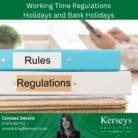Adverse Weather – What to Do
Adverse Weather – What to Do
Winter has now arrived bringing with it the possibility of winter traffic chaos. You can’t help the disruption caused by long delays and employees not getting into work. Yet you can make things run more smoothly if you plan ahead. In this article Adverse Weather – What To Do! we give you some points that you might want to consider when we next experience adverse weather.
To pay or not to pay?
When the adverse weather hits, employees will no doubt start phoning in. They may call because they are going to be late to work or say that they can’t make it in at all. So the first question most employers have to answer is do I pay or do I not pay?
In short, it is unlikely that you will be legally obliged to pay your employees for their period of lateness or their absence from work. The only exceptions to this will be where you have (a) an express term in your contracts of employment to say that you will pay your employees even if they are unable to make it into work, or (b) a custom and practice to this effect.
Putting aside your legal obligations, the question of whether you should pay your employees or not is a whole different question.
Pay?
Even if you are not legally obliged to pay your employees, you may wish to do so anyway. If you pay your employees this could help you avoid the negative impact on employee relations and morale caused by you deducting money from their wages. It would be hard to find anything more upsetting to an employee than taking money out of their pocket, even if you are entitled to do it. Your employee may have made every effort to get into work as normal. But they aren’t able to get in because of factors outside of their control. Larger employers may also wish to keep paying employees to reduce the possibility of bad publicity.
Or not?
But, if you pay all of your employees, even those who do not get into work, you may cause resentment among those who did struggle in. This resentment may be increased if those employees who did make it in are overstretched because of covering the workload for their absent colleagues. You may also set an unwanted precedent by paying those of your employees who aren’t able to make it in.
So, what should you do?
What is best for you will depend on a whole host of commercial, legal and logistical factors. You may decide to pay all your absent employees or none of them. You may decide to do something in between, such as paying them for a limited number of days’ absence caused by adverse weather each year. Or, you might want to allow them to do one or more of the following:
(a) make time up at a later date;
(b) take annual leave to cover their absence;
(c) work flexibly to avoid the worst of the traffic chaos;
(d) work from a different office; or
(e) work from home.
Plan for it!
Whatever you choose to do, it will me much smoother for you if you plan ahead.
You can take many practical steps to reduce business disruption. These would help avoid any confusion and minimise potential employment law claims, including:
- Developing a business continuity plan to cover for such things as widespread staff absence, temporary closure of your business and/or alternative workplace arrangements.
- Making arrangements for employees to work at an alternative location or at home. As part of this, you may need to look at the logistical and IT requirements, data protection issues and the health and safety implications for your employees. You may even wish to have a separate homeworking policy to cover off these points.
- Deciding what you are going to do if an employee can’t make it into work.
- Implementing an adverse weather and travel disruption policy and ensure that all of your employees are aware of it and its contents. In the policy you should clearly set out what is expected of your employees and what you will do in return. This will allow you to be more consistent in your approach, avoid any “shocks” for your employees and ensure that all employees are aware of their obligations.
Your adverse weather and travel disruption policy
When you prepare and implement a policy, you should consider including:
- the steps your employees are expected to take to get into work;
- the procedure your employees must follow if they are going to be late or they are unable to make it in;
- whether employees will be paid if they are unable to get to work;
- any arrangements to make up time later or take holiday instead;
- any flexible work arrangements, such as leaving early;
- how absences or lateness will be dealt with;
- what happens in the event of a workplace closure;
- how you will communicate with your employees;
- any provision for homeworking or working at an alternative location;
- the consequences for your employees of unauthorised absence or failure to follow the policy procedures.
Flexibility as well as consistency
You should ensure that you are as consistent and as fair as possible. Also you may need to exercise a degree of flexibility. This would be the case when deciding how to deal with any absence due to adverse weather or travel disruption. Building this into any policy you have will allow you to be pragmatic if you need to be. It may be unfair or unreasonable for you to treat everybody exactly the same.
For example, you may wish to consider and take into account such factors as:
- how far an employee lives from work
- other modes of transport available
- how critical their role is
- the availability of cover
- their carer responsibilities
You may also need to make reasonable adjustments for any employee who has a disability. That said, you must be careful when departing from the party line so as to avoid any possibility of you inadvertently discriminating against an employee.
How we can help
We can help you prepare for any potential disruption caused by adverse weather. This may include preparing a new policy for you to implement. We can, of course, also help you with any situation that arises along the way.
Find out more about Kerseys Employment Services here.
See the live weather report for Ipswich, Suffolk here.
Contact Us
[gravityform id=”5″ title=”false” description=”false”]







